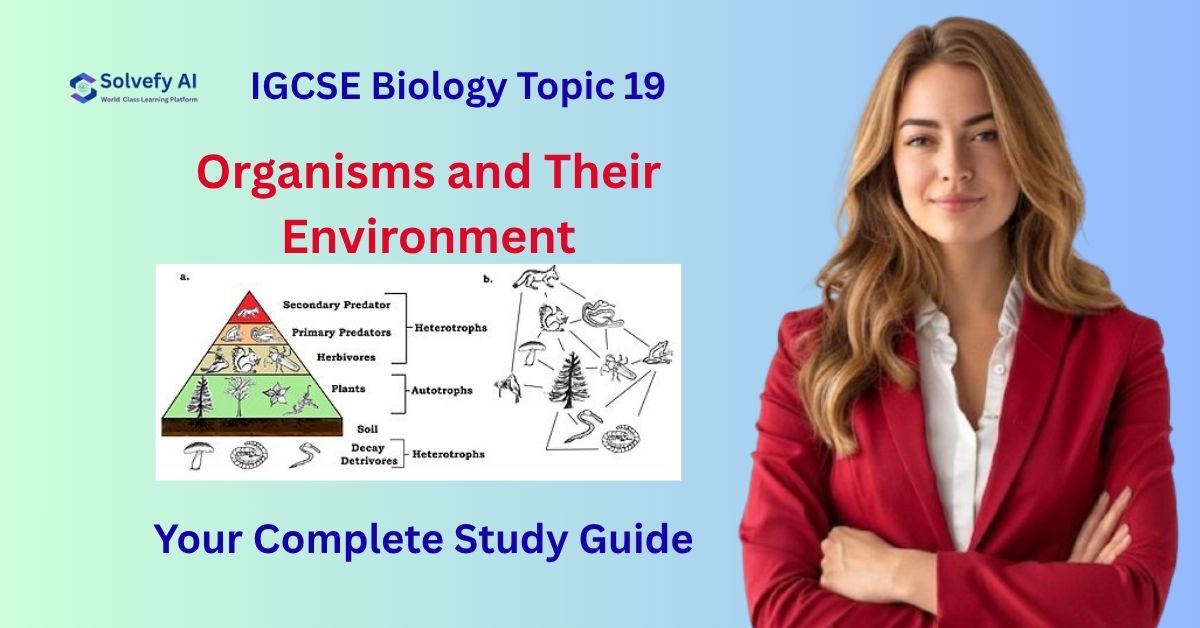Why Your Environment Matters More Than You Think
Have you ever wondered why polar bears don’t live in deserts, or why fish can’t survive on land? The answer lies in one of biology’s most fascinating topics: how organisms interact with their environment(Organisms and Their Environment). Right now, as you’re reading this, you’re part of a complex web of interactions involving sunlight, oxygen, food, and countless other organisms.
Understanding these connections isn’t just about passing your IGCSE exam – it’s about understanding how life itself works on our planet.
Topic 19 of your Cambridge IGCSE Biology syllabus (0610) explores these incredible relationships. Whether you’re aiming for that A* or just trying to make sense of ecosystems, this guide will break down everything you need to know in a way that actually makes sense. Let’s dive in!
Understanding the Basics: Key Definitions You Need to Know
Before we explore the complex interactions, let’s get our terminology straight. These definitions are your foundation – learn them well, and everything else will click into place.
Ecosystem: A unit containing all the organisms (the community) in a given area and their physical environment, interacting together. Think of it as a complete package – the living things plus their non-living surroundings.
Community: All the populations of different species living in the same habitat at the same time. For example, all the plants, animals, fungi, and microorganisms in a pond form a community.
Population: A group of organisms of the same species living in the same area at the same time. For instance, all the oak trees in a forest or all the rabbits in a field.
Habitat: The place where an organism lives. It’s their “address” in nature – like a coral reef for clownfish or soil for earthworms.
Niche: The role an organism plays in its ecosystem, including what it eats, what eats it, and how it interacts with both living and non-living factors. It’s like the organism’s “job” in nature.
Producer: An organism that makes its own food through photosynthesis (usually plants). They’re called producers because they produce food energy that supports the entire ecosystem.
Consumer: An organism that obtains energy by eating other organisms. This includes everything from herbivores to carnivores to omnivores.
Decomposer: An organism that breaks down dead organic material and returns nutrients to the environment. Bacteria and fungi are your main decomposers.
Energy Flow in Ecosystems: Following the Sun’s Journey
Here’s a mind-blowing fact: nearly all the energy in ecosystems originally came from the Sun. Let’s trace this incredible journey of energy through living things.
The Starting Point: Photosynthesis
It all begins with producers (mainly green plants) capturing light energy and converting it into chemical energy through photosynthesis:
Light energy + Carbon dioxide + Water → Glucose + Oxygen
Or in chemical notation:
6CO₂ + 6H₂O → C₆H₁₂O₆ + 6O₂
This glucose stores the energy that will pass through the entire ecosystem. Plants use some of this energy for their own life processes (respiration, growth, reproduction), but much remains stored in their tissues.
Food Chains: Energy’s Path Through Nature
A food chain shows the transfer of energy from one organism to another. Each stage in a food chain is called a trophic level.
Basic Food Chain Structure:
- Producer (1st trophic level): Green plants
- Primary consumer (2nd trophic level): Herbivores that eat plants
- Secondary consumer (3rd trophic level): Carnivores that eat herbivores
- Tertiary consumer (4th trophic level): Carnivores that eat other carnivores
Example Food Chain:
Grass → Grasshopper → Frog → Snake → Hawk

The Arrow Rules: Remember, arrows in food chains show the direction of energy flow, NOT who eats whom. The arrow points TO the organism receiving the energy. So “Grass → Rabbit” means energy flows from grass to rabbit (rabbit eats grass).
Food Webs: The Real Picture
In reality, organisms don’t follow simple chains – they form complex interconnected networks called food webs. Most animals eat more than one type of food, and most organisms are eaten by multiple predators.
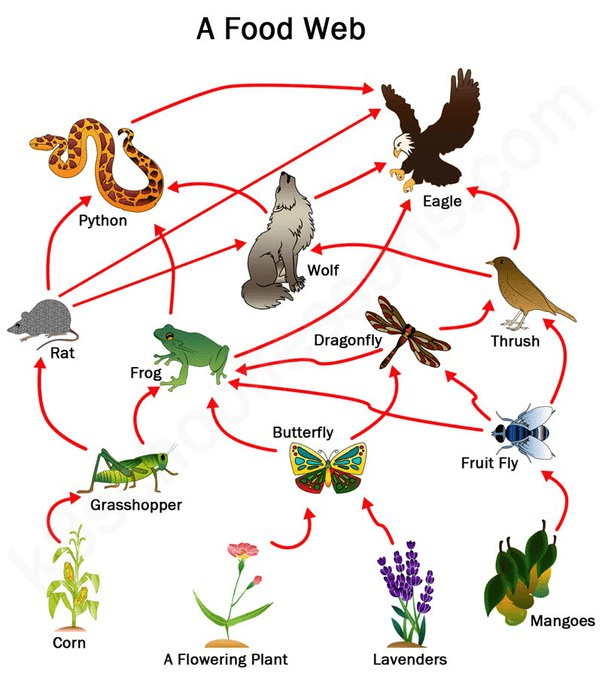
Why Food Webs Matter:
- They show the complexity of real ecosystems
- They explain why removing one species affects many others
- They demonstrate multiple feeding relationships
- They show how ecosystems are more stable than simple chains
The 10% Rule: Where Does the Energy Go?
Here’s something that surprises many students: only about 10% of energy passes from one trophic level to the next. Yes, you read that right – 90% is “lost”!
Where does the energy go?
- Respiration: Organisms use energy for movement, keeping warm, and other life processes. This energy is eventually released as heat.
- Not all parts eaten: Herbivores don’t eat roots; carnivores don’t eat bones, fur, or feathers.
- Not all parts digested: Some material passes through as waste (feces).
- Movement and heat loss: Active organisms lose significant energy as heat to the environment.
Why This Matters:
This explains why food chains rarely have more than 4-5 trophic levels – there simply isn’t enough energy to support more! It also explains why there are always more producers than primary consumers, and more primary consumers than secondary consumers.
Pyramids of Numbers, Biomass, and Energy
We can represent the structure of ecosystems using pyramids:
Pyramid of Numbers: Shows the number of organisms at each trophic level. Usually pyramid-shaped, but not always (think of one oak tree supporting thousands of insects).
Pyramid of Biomass: Shows the total mass of living material at each level. Almost always pyramid-shaped because of energy loss. Biomass is measured in dry mass (g/m² or kg/m²).
Pyramid of Energy: Shows the energy content at each level. Always pyramid-shaped with no exceptions, because energy is always lost between levels.
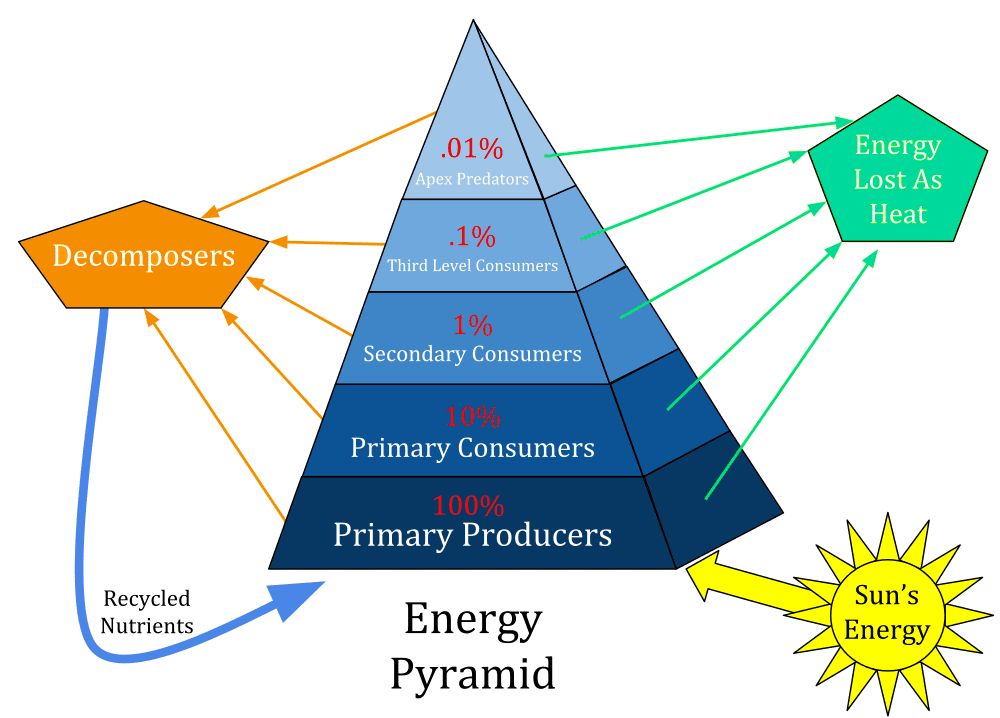
Memory Tip: “Energy pyramids are Exceptional – they’re Every time perfect pyramids!”
Nutrient Cycles: Nature’s Perfect Recycling System
Unlike energy (which flows one way through ecosystems), nutrients are recycled. Let’s explore the two most important cycles for your exam.
The Carbon Cycle: Carbon’s Journey Through Life
Carbon is essential for all living things – it’s in proteins, carbohydrates, fats, and DNA. Here’s how it cycles through ecosystems:
Key Processes in the Carbon Cycle:
- Photosynthesis: Plants remove CO₂ from the atmosphere and convert it into organic compounds (glucose, starch, cellulose).
- Feeding: Carbon passes through food chains as animals eat plants and other animals.
- Respiration: All living organisms (plants, animals, decomposers) release CO₂ back into the atmosphere through respiration.
- Decomposition: When organisms die, decomposers break down their bodies, releasing CO₂ through respiration.
- Combustion: Burning fossil fuels (coal, oil, natural gas) and wood releases CO₂. This is increasing atmospheric CO₂ levels, contributing to climate change.
- Fossilization: Over millions of years, dead organisms can be converted into fossil fuels (coal, oil, gas), temporarily removing carbon from the cycle.
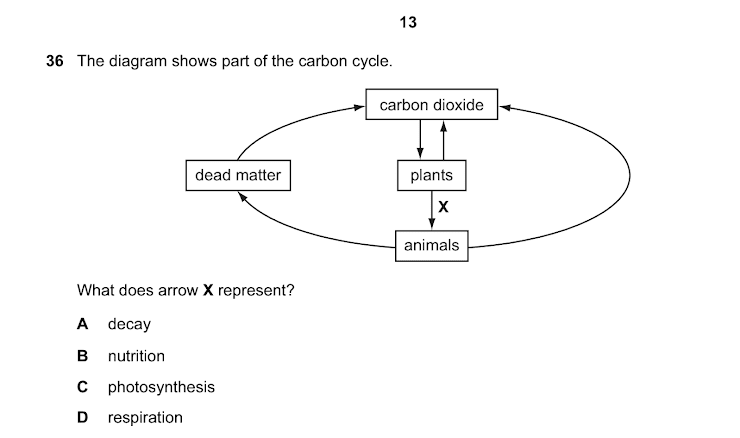
The Balanced System: In a natural, undisturbed ecosystem, the carbon cycle is balanced – the amount of CO₂ removed by photosynthesis equals the amount released by respiration and decomposition. Human activities, particularly burning fossil fuels and deforestation, are disrupting this balance.
The Nitrogen Cycle: Nature’s Fertilizer Factory
Nitrogen is crucial for making proteins and DNA, but here’s the catch: although the atmosphere is 78% nitrogen gas (N₂), most organisms can’t use it directly! Enter the nitrogen cycle – one of nature’s most ingenious solutions.
Key Processes in the Nitrogen Cycle:
- Nitrogen Fixation: Converting atmospheric nitrogen (N₂) into nitrogen compounds plants can use:
- Lightning: Provides energy to combine nitrogen with oxygen
- Nitrogen-fixing bacteria: Live in soil or in root nodules of legumes (peas, beans, clover). They convert N₂ into ammonia and nitrates.
- Absorption: Plants absorb nitrates from the soil through their roots and use them to make proteins.
- Feeding: Animals obtain nitrogen by eating plants or other animals (consuming proteins).
- Decomposition: When organisms die, or produce waste (urine, feces), decomposers break down proteins and urea:
- Decomposers break down proteins into ammonia
- Nitrifying bacteria convert ammonia into nitrites, then into nitrates (nitrification)
- Plants then absorb these nitrates – the cycle continues!
- Denitrification: Denitrifying bacteria in waterlogged, oxygen-poor soil convert nitrates back into nitrogen gas (N₂), returning it to the atmosphere. This seems wasteful, but it’s important for balance.
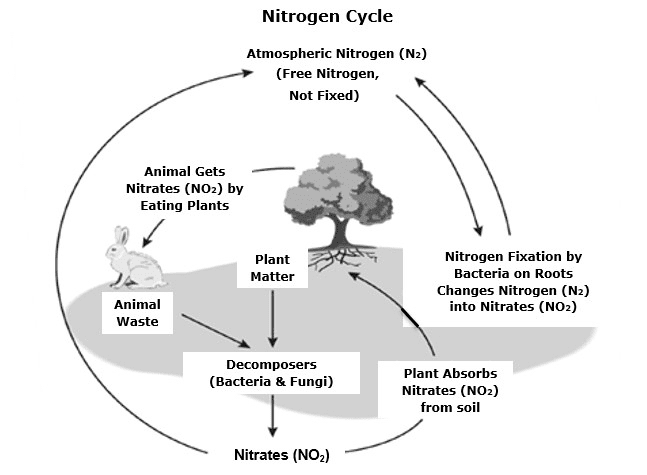
Key Players – The Bacteria:
- Nitrogen-fixing bacteria: Azotobacter (in soil), Rhizobium (in root nodules)
- Nitrifying bacteria: Convert ammonia → nitrites → nitrates
- Decomposers: Break down dead material and waste
- Denitrifying bacteria: Convert nitrates → nitrogen gas
Why Farmers Love Legumes: Legume plants (peas, beans, clover) have root nodules containing nitrogen-fixing bacteria. When farmers grow legumes, they’re naturally enriching the soil with nitrates – free fertilizer! This is called crop rotation.
Population Dynamics: Why Numbers Change
Populations don’t stay constant – they grow, shrink, and stabilize based on various factors.
Factors Affecting Population Size
Factors that Increase Population:
- High birth rate
- Immigration (organisms moving in)
- Abundant food supply
- Favorable environmental conditions
- Few predators or diseases
Factors that Decrease Population:
- High death rate
- Emigration (organisms moving out)
- Food shortage
- Unfavorable conditions (temperature, pH, lack of water)
- Many predators or diseases
- Accumulation of toxic waste
Predator-Prey Relationships
Predator and prey populations show cyclical changes that are beautifully interconnected:
- Many prey → Predators have plenty of food → Predator population increases
- Many predators → More prey are eaten → Prey population decreases
- Few prey → Predators starve → Predator population decreases
- Few predators → Less prey eaten → Prey population increases
- The cycle repeats!
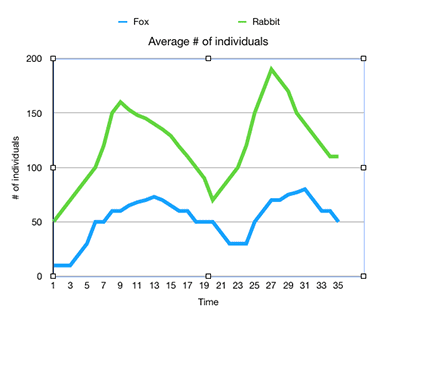
Important Pattern: The prey population peak always comes slightly before the predator population peak. Why? Because it takes time for predators to reproduce after food becomes abundant.
Human Impact on the Environment
Humans have become the most powerful force shaping ecosystems. Let’s examine our impacts – both negative and positive.
Negative Impacts
1. Deforestation:
- Consequences: Habitat loss, species extinction, soil erosion, reduced CO₂ absorption (contributing to climate change), disruption of water cycles
- Causes: Agriculture, logging, urbanization, mining
2. Pollution:
- Air pollution: Burning fossil fuels releases CO₂ (climate change) and sulfur dioxide (acid rain)
- Water pollution: Sewage, fertilizers, pesticides, industrial waste
- Eutrophication: Excess fertilizers in water → algae bloom → blocks light → plants die → decomposers use up oxygen → fish suffocate
- Plastic pollution: Non-biodegradable waste harming wildlife
3. Overexploitation:
- Overfishing leading to population collapse
- Hunting endangered species
- Unsustainable harvesting of resources
4. Climate Change:
- Increasing CO₂ from burning fossil fuels
- Rising global temperatures
- Melting ice caps, sea level rise
- Changing weather patterns affecting ecosystems
Positive Actions: Conservation and Sustainability
Conservation Methods:
- Protected areas: National parks, nature reserves
- Breeding programs: For endangered species
- Sustainable fishing: Quotas, net size regulations, closed seasons
- Reforestation: Planting trees to restore habitats
- Reducing pollution: Cleaner technologies, waste treatment
- Recycling: Reducing resource extraction and waste
Sustainable Development: Meeting current needs without compromising future generations’ ability to meet their needs.
Common Exam Questions and How to Answer Them
Let’s tackle the types of questions you’ll face in your IGCSE exam:
Question Type 1: Describe the flow of energy through a food chain
Good Answer Structure:
- Start with the Sun as the energy source
- Explain photosynthesis captures light energy
- Describe energy passing through trophic levels
- Mention that only ~10% passes between levels
- Explain where energy is “lost” (respiration, heat, waste, uneaten parts)
- Note that energy flow is one-way (unlike nutrients)
Question Type 2: Explain the importance of decomposers
Key Points to Include:
- Break down dead organisms and waste
- Release nutrients back into soil
- Enable nutrient recycling
- Without them, nutrients would be locked in dead matter
- Make nutrients available for plants to absorb
- Essential for maintaining ecosystem productivity
Question Type 3: Describe the carbon/nitrogen cycle
Approach:
- Name the key processes (for carbon: photosynthesis, respiration, decomposition, combustion)
- Explain what each process does
- Link processes together showing the cycle
- Mention the organisms involved
- Include relevant chemical equations if asked
Question Type 4: Explain how [human activity] affects the environment
Structure:
- State the immediate effect
- Explain the consequences
- Link to broader ecosystem impacts
- Consider both short and long-term effects
- Mention possible solutions if relevant
Quick Revision Notes
Energy Flow:
Energy enters ecosystems through photosynthesis
Energy flows one way through food chains/webs
Only ~10% transfers between trophic levels
Energy pyramids are always pyramid-shaped
Arrows show energy flow direction
Carbon Cycle:
Photosynthesis removes CO₂ from atmosphere
Respiration returns CO₂ to atmosphere
Combustion of fossil fuels increases atmospheric CO₂
Decomposition releases CO₂ from dead matter
Carbon passes through food chains via feeding
Nitrogen Cycle:
Nitrogen fixation converts N₂ to nitrates (bacteria + lightning)
Plants absorb nitrates to make proteins
Decomposers break down waste/dead matter to ammonia
Nitrifying bacteria convert ammonia → nitrites → nitrates
Denitrifying bacteria convert nitrates → N₂
Population Dynamics:
Populations change due to births, deaths, immigration, emigration
Predator-prey populations show cyclical patterns
Prey population peaks before predator population
Human Impact:
Deforestation causes habitat loss, extinction, climate change
Pollution harms organisms and disrupts ecosystems
Eutrophication: fertilizers → algae bloom → oxygen depletion
Conservation requires protected areas, sustainable practices, reducing pollution
Common Mistakes to Avoid
Mistake #1: Reversing food chain arrows
WRONG: Grass ← Rabbit (arrows should point to the organism gaining energy)
CORRECT: Grass → Rabbit
Mistake #2: Confusing energy flow with nutrient cycling
- Energy flows ONE WAY (and is eventually lost as heat)
- Nutrients are RECYCLED (used over and over)
Mistake #3: Saying “energy is lost”
- Energy isn’t destroyed (First Law of Thermodynamics!)
- Say: “energy is transferred to the environment as heat” or “energy is used in respiration”
Mistake #4: Forgetting about decomposers
- They’re crucial for recycling nutrients
- Always mention them in nutrient cycle questions
Mistake #5: Not being specific about bacteria types
- There are different bacteria for different jobs in the nitrogen cycle
- Know: nitrogen-fixing, nitrifying, denitrifying, and decomposers
Mistake #6: Vague answers about human impact
- Don’t just say “pollution is bad”
- Explain the mechanism: how does it harm organisms? What’s the chain of effects?
Key Formulas and Equations Box
PHOTOSYNTHESIS:
6CO₂ + 6H₂O → C₆H₁₂O₆ + 6O₂
(Carbon dioxide + Water → Glucose + Oxygen)
RESPIRATION:
C₆H₁₂O₆ + 6O₂ → 6CO₂ + 6H₂O + Energy
(Glucose + Oxygen → Carbon dioxide + Water + Energy)
ENERGY TRANSFER EFFICIENCY:
Efficiency = (Energy in higher level / Energy in lower level) × 100%
Typically ~10% between trophic levels
POPULATION CHANGE:
Population change = (Births + Immigration) - (Deaths + Emigration)Test Yourself: Practice Questions
Basic Level:
- Define the terms: ecosystem, community, population, habitat
- Name the process by which green plants produce food
- What is the role of decomposers in an ecosystem?
- In a food chain, which direction do arrows point?
Intermediate Level:
- Explain why food chains rarely have more than five trophic levels
- Describe the role of nitrogen-fixing bacteria in the nitrogen cycle
- Outline how carbon is cycled through an ecosystem
- Explain the relationship between predator and prey populations
Advanced Level:
- Discuss the consequences of eutrophication on aquatic ecosystems
- Evaluate the effectiveness of different conservation strategies for endangered species
- Explain how deforestation contributes to climate change
- Compare and contrast pyramids of numbers and pyramids of biomass
Study Tips for Exam Success
1. Master the Cycles: Draw the carbon and nitrogen cycles from memory repeatedly until they’re automatic. Use colors to distinguish different processes.
2. Practice Drawing Food Webs: Start simple, then add complexity. This helps you understand interconnections.
3. Use Real Examples: Connect concepts to real ecosystems (local woodland, pond, or ocean). This makes abstract ideas concrete.
4. Create Flashcards: For key terms, processes, and bacterial types. Review them daily.
5. Explain Out Loud: Teach the topic to a friend, parent, or even your pet! If you can explain it clearly, you understand it.
6. Watch for Command Words:
- Describe: Say what happens
- Explain: Say what happens AND why
- Compare: State similarities and differences
- Evaluate: Make judgments about effectiveness
7. Practice Past Papers: Familiarize yourself with question styles and mark schemes. Time yourself to build exam stamina.
Comparison Table: Key Differences
| Aspect | Food Chain | Food Web |
|---|---|---|
| Complexity | Simple, linear | Complex, interconnected |
| Pathways | Single pathway | Multiple pathways |
| Stability | Less stable | More stable |
| Reality | Simplified model | More realistic |
| Type of Bacteria | Function | Location |
|---|---|---|
| Nitrogen-fixing | N₂ → ammonia/nitrates | Soil, root nodules |
| Nitrifying | Ammonia → nitrites → nitrates | Soil |
| Decomposers | Dead matter → ammonia | Soil, dead organisms |
| Denitrifying | Nitrates → N₂ | Waterlogged soil |
| Impact | Cause | Consequence |
|---|---|---|
| Deforestation | Agriculture, logging | Habitat loss, species extinction, climate change |
| Eutrophication | Excess fertilizers | Algae bloom, oxygen depletion, fish death |
| Climate change | CO₂ from fossil fuels | Rising temperatures, sea level rise, ecosystem disruption |
| Overfishing | Unsustainable harvesting | Population collapse, ecosystem imbalance |
Your Next Steps: Keep Learning!
Congratulations on making it through this comprehensive guide! You’ve now covered all the essential concepts for Topic 19: Organisms and Their Environment. But learning doesn’t stop here.
Related Topics to Explore:
- Topic 6: Plant Nutrition – Dive deeper into photosynthesis
- Topic 12: Respiration – Understand how organisms release energy
- Topic 13: Excretion – Learn about waste removal in organisms
- Topic 20: Human Influences on Ecosystems – Expand on conservation
Action Plan for Success:
- This week: Create mind maps for both nutrient cycles
- Next week: Practice drawing food webs for different ecosystems
- Ongoing: Complete 5 past paper questions on this topic each week
- Before exam: Do timed practice papers under exam conditions
Remember: Understanding ecosystems is about seeing connections. Everything in nature is linked. When you truly grasp these relationships, you’re not just memorizing for an exam – you’re understanding how our planet works. That’s powerful knowledge!
Stay Motivated: Every biologist, conservationist, and environmental scientist started exactly where you are now. The fact that you’re investing time to understand these concepts shows you care about learning. Trust the process, practice regularly, and remember: you’ve got this!
Final Encouragement: Topic 19 appears challenging because it involves multiple interconnected concepts, but that’s also what makes it beautiful. Once the pieces click together, you’ll see the elegant logic of nature’s systems. Take it one concept at a time, use diagrams liberally, and don’t hesitate to revisit sections that challenge you. Your future self (and possibly the planet!) will thank you for understanding these crucial concepts.
Good luck with your studies, and may your understanding of ecosystems grow as richly as a tropical rainforest!
Recommended –

